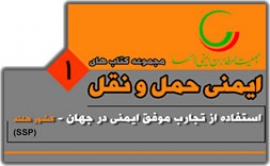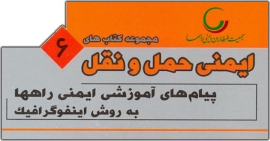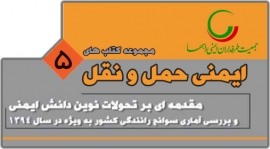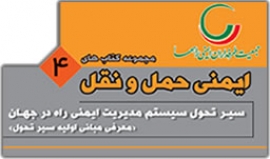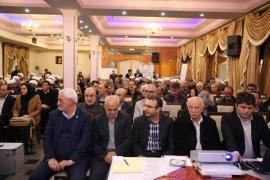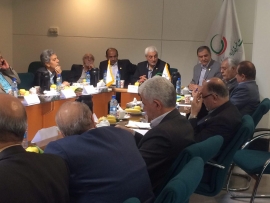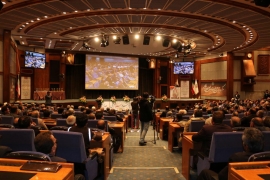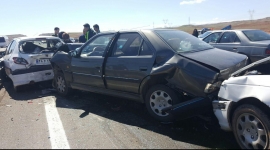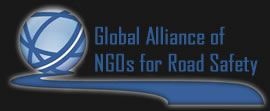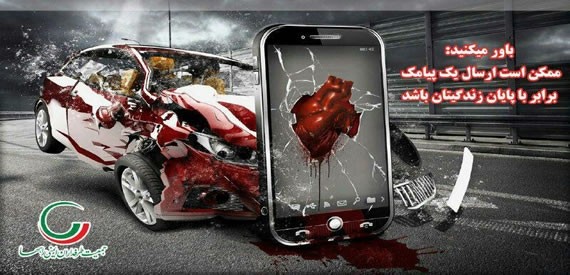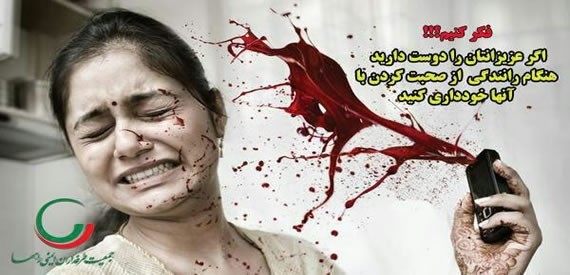RSSS Holds 2nd GA Meeting - 2017
According to its Articles of Association, the General Assembly of the Road Safety Supporters Society meets every other year. The 2nd General Assembly meeting of RSSS convened at the Laleh Cultural Center from 16:00 to 18:00 on Tuesday March 7, 2017 following invitation letters sent to the participants.
The meeting was attended by Ahmad Khorram and Mohammad Rahmati, two former ministers of roads and transportation; Commander Mohammad HosseinHamidi, the rural traffic police chief;Engineer ShahramAdamnejad, Vice President of the Road Maintenance and Transport Organization; and the special envoy of the Ministry of the Interior.
After electing the Board of Governors the session heard a report by chairman of the board on the performance of the RSSS as well as a report by the inspector on the financial record which were approved by the General Assembly.
The Board of Governors in the presence of HadiHashemi (former traffic police chief of greater Tehran), Hamid Safarian(chairman of the RSSS Cultural Committee) and Abbas Qolizadeh invited the participants to nominate for membership in the Board.
After voting, the following persons were elected as the main members of the Board of Directors for a period of two years:
Name Votes
1. Mohammad Bokharaei 110
2. Alireza Esmaeili 98
3. Behrooz Gharavi 94
4. ShahramAdamnejad 90
5. NaserRazzaq-Manesh 75
6. Ali Azad 61
7. PouryaMohammadian 58
8. SadeqAfshar 53
9. MajidrezaNasrollah-Nejad 50
Meanwhile, the following persons were elected as alternate members of the Board of Directors:
10. MarziehHesari 44
11. Hassan Momeni 43
12. HosseinaliQolizadeh 42
Also, Mohammad QasemPourtaqi (with 68 votes) and Ali Haqayeq (with 26 votes) were elected the main and alternate inspectors respectively.
RSSS Strategic Plan for 2016/2017
The strategic plan of the Road Safety Supporters Society (RSSS) in the calendar year 1395 (2016/2017) was announced at a gathering of the headquarters and provincial managers as follows:
Operational Strategy of Provincial Offices in 1395 (2016-2017)
The Road Safety Supporters Society (RSSS) started its activities in 1386 (2007-2008) by reliance on the Almighty God with an aim of improving the status of road traffic safety and promoting traffic culture as a national, non-governmental and non-political institute and by benefiting from the experience and knowledge of its members.
With firm belief in this motto, the RSSS members and supporters started observance of the safety principles and correcting risky behaviors in driving as a first step within themselves in the forefront with the ideal slogan of ‘even one dead is too many’,
The society strives to improve and correct behavior of the road users and change their high risk behaviors into safe behaviors based on the observance of driving rules and regulations through operational strategies prioritizing safety of motorcyclists. The society is persuing the following goals in provinces:
1- Efforts for maximum participation of people in the promotion of roads safety
• Using the potentials of social networks including websites
• Preparing and distributing educational brochures and disseminating information
• Using environmental advertising media
• Using the broad-based provincial IRIB media
• Training to promote students’ safe behavior
2- Holding safety alliance conference
• Holding a nationwide conference participated by a thousand people from various walks of life
• Setting up safety brainstorm seminars with the participation of different groups, including professors, cultural and educational associations, transportation guild associations, and the like to create sensitivity and propagate the safe behavior culture
• Holding safety campaign and free tribune at appropriate opportunities
• Making efforts to participate in the meetings of the provincial safety committee and commission
• Putting into operation the plan of safety pioneers specific for students with the coordination of the central cultural committee
3- Holding safety operational maneuvers for the users
• Motorcyclists Maneuver along with distribution of brochures, holding classes and other culture building tools
• Maneuver of public transportation fleet drivers
• Field operations maneuver for pedestrians in order to improve safe traffic behaviors
• Truck drivers maneuver
• All drivers maneuver (distribution of brochures, educational messages, etc.)
4- Maximum membership acceptance and attraction of sponsors and financial and spiritual supporters
• Extensive membership acceptance from people and different social groups
• Establishing constant communication with the members through different means, including website, email, SMS, social networks
• Receiving membership fee through possible methods
• Attracting sponsors and financial supporters for the implementation of cultural and social programs
5. Organizing structure of provincial offices
• Holding annual meeting with the society’s Board of Trustee in the provinces
• Holding constant meetings of the Executive Board and sending relevant minutes of the meetings to the RSSS headquarters
• Preparing and submitting monthly reports to the provincial Executive Manager and Managing Director of the Society
First Professional Drivers Safety Alliance Festival
The First Professional Drivers Safety Alliance Festival was held at the IRB Convention Center (December 19) in the presence of Minister of Roads and Urban Development, his deputies, Roads Police Commander, a number of directors and deputies of the Roads Maintenance and Transportation Organization and about 700 professional drivers.
Mohammad Bokharaei, Chairman of the Board of Directors of Road Safety Supporters Society (RSSS) welcoming the audience said the permanent secretariat of the Professional Drivers Safety Alliance Festival will be set up after Nowruz 1396 (New Iranian Year starting March 21, 2017).
He said the next year selection of drivers will be held at provincial level, adding that after selecting safe drivers out of 31 provincial festivals, a safety festival will be held on April 26 and top professional drivers will be introduced at national level.
Stating that currently there are over 2.5 million professional drivers with membership in the safety campaign, he added that the target of this festival is to reduce road casualties by half so that by the end of the Sixth and Seventh Development Plans the number of road traffic deaths will be cut by another 11 thousand.
Bokharaei noted that the public culture is indebted to the drivers, adding that in order to promote the dignity of the drivers from now on we will call them “honest leaders”. He said the philosophy behind naming this festival is success of all those involved in the field of road transportation.
He added: “This year 1400 drivers participated in the festival which is a considerable figure and we expect more participants in the next events and all the drivers would be honored as top and safe drivers.”
Also addressing the forum, Minister of Roads and Urban Development Abbas Akhundi said thanks to the cooperation of all the executive bodies and responsible drivers, over the past 10 years the number of deaths in road crashes has been reduced by 11 thousand.
He added that currently, the number of motor vehicles in the country has reached about 28 million and almost every Iranian family owns a car. “This has made the task of the authorities in promoting road traffic safety even more difficult.”
He stressed that papplication of smart management on the roads and use of 1800 surveillance cameras in the country as well as the smart system for the close control of drivers’ behavior is highly important in order to reduce the high-risk behavior of the drivers and crashes on the roads.
Unnderlining the need for introducing more stringent regulations in the process of issuing driving license, Dr. Akhundi added that this issue has been put on the agenda of the Road Safety Commission so that by taking more strict steps in the process, the drivers’ high-risk behavior on the roads will be minimized.
Meanwhile, Engineer Davoud Keshavarzian, Deputy Minister of Roads and Urban Development and Head of the Road Maintenance and Transportation Organization referred to the factors effective in reducing road crashes and said the issue of road casualties and crashes is a social issue and social institutions should get involved in order to reduce the casualties.
Noting that one of the main plans of the Roads Maintenance and Transportation Organization is promotion of road safety, he said in addition to installation of traffic violation monitoring systems and vehicle control smart systems, new regulations for registration of transportation companies, branding and promoting quality of services of cargo and passenger transportation companies, all aim at safety matters.
Keshavarzian, emphasizing that the topic of safety should be turned into a culture noted that it is hoped all road transportation activists will bring people more safety by improving the traffic culture,.
Road traffic police commander, Mohammad Hossein Hamidi, was another speaker who said reduction in the number of road casualties in Iran shows that drivers play an effective role in reducing crashes.
He said there is more than 200 thousand km of road in the country the control of which as well as the behavior of drivers is not an easy task.
The Police Commander said 400 cities in the country possess traffic and driving structure and 800 cities are controlled by surveillance cameras.
At the end of the ceremony, golden tablets were awarded to ten selected professional drivers and crystal tablets to another 20 top drivers.
Public Relations Office
Road Safety Supporters Society
Estimated Cost of National Road Traffic Injuries
Road traffic injuries in Iran waste a major part of the national wealth and output in the country. By spending a small part of this cost on road immunization plans and programs the waste can be avoided to a great extent; on the other hand by preventing such waste a significant help can be rendered to the economic growth. In other words, making small investment on improvement of road safety in Iran will result in the return of outstanding capital to such extent that it will justify implementation of each plan, no matter how ambitious, in this regard. Therefore, growth of technology, education and infrastructures, will be in line with the improvement of traffic safety as a basic factor in the development of the country.
In this project, with the focus on the burden of health resulting from traffic injuries in Iran, efforts have been aimed to seek the quantitative amount or, in other words, its economic burden. By dividing the costs into two direct and indirect costs, the objective and mental dimensions of this economic burden will be quantified. For this purpose, efforts have been made to use a combination of the experiences available in Iran, the international directives and experiences of developed countries in this project. By using these experiences and the collected data during this study, the elements of the cost and their amount have been achieved in the calendar year 1390 (2011/2012) as shown in the Table (1-7).
This estimated cost has been made for the entire people injured in traffic crashes throughout the country and in the three classifications of main category, elements of cost and details of the costs. In this table and figure (1-7), it is seen that medical costs in the main category, the lost output among elements of the cost and post-release costs among details of the cost have allocated the highest share of the traffic injuries cost to themselves.
Part II: Estimated cost of road traffic injuries
Table 1-7: Road traffic injuries cost in Iran in 1390 (2011/2012)
| Main Category | Elements of Cost | ||||
| Heading | Cost (Billion IRR) | Cost Ratio | Heading | Cost (Billion IRR) | |
| Medical costs | 46/237/520 | 41.53 | Pre-hospital costs | 1/022/692 | |
| Treatment costs | 15/738/828 | ||||
| Post-release costs | 29/476/000 | ||||
| Lost output | 3/499/172 | 31.43 | Lost national output | 3/499/172 | |
| Indirect costs | 30/107/727 | 27.04 | Pain, grief and suffering (reduced quality of life) | 2/9846/740 | |
| Reduced functional capacity | 260/987 | ||||
| 34/954/788 | ------- | Willingness to pay | 34/954/788 | ||
| The total cost of road traffic injuries using human capital (medical costs, lost output and reduced quality of life):111,342 billion IRR | |||||
| Cost ratio | Heading | Cost (Billion IRR) | Cost Ratio (%) |
| 0.919 | Emergency 115 | 917/445 | 0.82 |
| Firefighting and Red Crescent | 55/508 | 0.05 | |
| Transfer by private car | 49/739 | 0.04 | |
| 14.136 | Hospital treatment (public payment) | 3/713/220 | 3.33 |
| Hospital treatment (private payment) | 11/987/000 | 10.77 | |
| Non-hospital treatment | 38/608 | 0.03 | |
| 26.473 | Post-release costs | 29/476/000 | 26.47 |
| 31.432 | Caused by casualties | 22/822/181 | 20/50 |
| Caused by physical disabilities | 12/174/991 | 10.93 | |
| 26.806 | Pain, grief and suffering (reduced quality of life) caused by casualties | 9/496/880 | 8.53 |
| Pain, grief and suffering (reduced quality of life) caused by physical disabilities | 20/349/860 | 18.28 | |
| 0.234 | Caused by injuries | 260/987 | 0.23 |
| -------- | Total value of lost lives | 34/954/788 | ----- |
Medical costs 42%
Indirect costs 27%
Lost output 31%
Pre-hospital costs 1%
Treatment costs 14%
Post-release costs 27%
Pain, grief & suffering (reduced quality of life) 27%
Lost national output 31%
Figure 1-7: Share of each cost element of traffic injuries in Iran in 1390 (2011/2012)
Part II: Estimated cost of road traffic injuries
Emergency 115
Firefighting and Red Crescent
Transfer by private car
Hospital treatment (public payment)
Hospital treatment (private payment)
Non-hospital treatment
Post-release costs
Lost national output caused by casualties
Lost national output caused by physical disabilities
Pain, grief and suffering (reduced quality of life) caused by casualties
Pain, grief and suffering (reduced quality of life) caused by physical disabilities
Reduced functional capacity caused by injuries
Figure 1-7: (Cnt’d) – Share of each cost element of traffic injuries in Iran in 1390 (2011/2012)
Finally, by summing up the total cost through human capital method, the economic burden caused by road traffic fatalities in Iran in 1390 (2011/2012) has been estimated at more than 111 thousand billion IRR. It should be noted that this cost is only related to the health sector and does not include elements such as damage to vehicles, the time lost in accidents and administrative costs of insurance and the police. Therefore, with the calculations of the GDP equal to 5,100,000 billion IRR in 1390 (Chapter 5) the estimated cost in the health sector has been about 2.18% of the total GDP in that year. In addition, this figure has a value of equivalent to 75% of the total budget allocated to the health sector in 1390 (151,388, 924 million IRR). As a rough estimate and with regard to the previous experiences in Iran in the estimated cost of traffic accidents in which costs related to the health sector has been about 61% of the total cost of the accidents in the country (Ayati, 1387), the total cost of accidents is estimated over 196 thousand billion IRR, i.e. 3.85% of the GDP.
The above-mentioned amounts express the national and macro-level costs of the country. In addition to this macro estimation, there is need to calculate the cost endured by each victim of traffic crashes (injured or dead) which is calculable on the basis of macro costs. Estimation of individual costs is in need of the awareness of elements of effective cost on each category of the severity of the injuries. In other words, it should be specified what cost each death, disability or injury impose on the society. For this purpose, in Tables (2-7) up to (4-7) all the cases detailed in the process of calculation of the costs for the estimation of individual costs of death, disability and injury have been used.
Table (2-7) shows the elements of cost related to each death by using the human capital approach and willingness to pay. It is noted that the total cost figures, by using the WTP method, are a bit higher which is totally rational. Table (3-7) shows the cost caused by each physical disability and Table (4-7) shows the total medical costs and reduced functional capacity of the injured for any level of injury. In Figure (2-7), the scale of individual costs for each death has been shown by using the two methods of human capital and the willingness to pay.
In conclusion, it is necessary to present a summary description of the key results obtained from different analytical processes during this study. Table (5-7) shows the summary of the results achieved.
Table 2-7: Estimated cost of each traffic death in 1390 (Million IRR)
| Elements of Cost | Section Under Study | Human Capital Method | Willingness to Pay Method |
| Medical | Table 2-6 | 79/568 | 79/568 |
| Lost output | Para 3-5 | 1136/05 | 0 |
| Cost of pain, grief and suffering | Para 1-1-6 | 472/7 | 0 |
| Value of statistical life | Para 2-6 | 0 | 1740 |
| Total cost of each death | ------ | 1/688/318 | 1819/568 |
Table 3-7: Estimated cost caused by any disability in 1390 (Million IRR)
| Elements of Cost | Section Under Study | Human Capital Method |
| Medical | Table 4-6 | |
| Lost output | Para 3-5 | 307/13 |
| Cost of pain, grief and suffering | Para 1-1-6 | 513/35 |
| Reduced functional capacity | Para 3-6 | 14/19 |
| Total cost of each disability | ------ | 1063/206 |
Table 4-7: Estimated cost caused by traffic injuries at any severity level in 1390 (Million IRR)
| Injury severity group | Treatment costs of the injured (public payment) | Treatment costs of the injured (private payment) | Post-release costs | Pre-hospital costs | Reduced functional capacity | Total |
| Non-hospital treatment | 0.000 | 0.246 | 0.000 | 0.000 | 0.000 | 0.246 |
| Outpatient injury | 0.246 | 0.000 | 1.105 | 0.000 | 1.351 | |
| 1 | 6/216 | 12/828 | 31/300 | 1/105 | 0/005 | 51/454 |
| 2 | 48/094 | 24/460 | 59/400 | 1/105 | 0/143 | 133/202 |
| 3 | 147/875 | 28/926 | 81/700 | 1/105 | 1/269 | 260/875 |
| 4 | 316/412 | 47/000 | 149/500 | 1/105 | 6/960 | 520/978 |
| 5 | 573/393 | 39/400 | 343/300 | 1/105 | 30/503 | 987/701 |
| 6 | 813/317 | 20/000 | 310/000 | 1/105 | 132/423 | 1276/845 |
Table 2-7: Comparison between individual costs for each death and disability (Million IRR)
Cost of each disability
Cost of each death on the basis of willingness for payment
Cost of each death on the basis of human capital
Reduced functional capacity
Value of statistical life
Cost of pain, grief and suffering
Lost output
Medical
Table 5-7: Summary of the results obtained in the estimated cost of traffic injuries in Iran in 1390 (2011/2012)
| Main Categories | Description of Result | Amount |
| Medical Costs | The share of the country’s emergency missions that have been related to traffic crashes | 23% |
| Share of emergency traffic crashes missions in cities | 72% | |
| Credits related to current costs of emergency services and medical emergencies in 1390 | Over 2400 Billion IRR | |
| Share of traffic injuries in fixed costs of emergency stations | About 732 Billion IRR | |
| Total cost of traffic crash missions of Emergency 115 | Over 185 Billion IRR | |
| Share of traffic injuries in total costs of Emergency 115 | Over 917 Billion IRR | |
| Cost of firefighting, relief and rescue of the Red Crescent | 55.5 Billion IRR | |
| Share of private clients out of the total traffic injuries admissions | 40% | |
| Cost related to transfer of the injured by private vehicles | 49.7 Billion IRR | |
| Total costs spent on treatment of traffic injured within the framework of Article 92 | 3713.2 Billion IRR | |
| Average cost of each night of hospitalization for different groups of traffic injuries | 983 thousand IRR | |
| Total number of outpatients injured in traffic throughout the country | Over 337 thousand people | |
| Treatment cost of outpatient victims of traffic crashes in the country | About 82.9 Billion IRR | |
| Hospital treatment costs paid by the victims of traffic crashes themselves | About 12000 Billion IRR | |
| Number of injured not transferred to hospital and received non-hospital treatment | Over 157 thousand people | |
| Total cost of non-hospital treatment of the injured not transferred to hospital | About 38.6 Billion IRR | |
| Number of traffic injured released from hospitals throughout the country | Over 820 thousand people | |
| Total post-release treatment costs | Over 29000 Billion IRR | |
| Lost Output | Total number of those killed in traffic crashes | 20089 people |
| Country’s GDP in 1390 (2011/2012) | 5100 thousand Billion IRR | |
| Per capita GDP in 1390 | 72.1 Million IRR | |
| Average age of the dead in traffic crashes | 35.7 years | |
| Total number of years of lost life for all ages and all victims of traffic crashes (YLL) | 176,168 years | |
| Average years of lost life related to each death caused by traffic crashes | 8.77 years | |
| Number of permanent physical disability in 1390 | 211 people | |
| Total number of years of lost life for all ages and all injured suffering from a degree of disability due to traffic crashes (YLD) | 143,411 | |
| Average years of lost life related to each disability caused by traffic crashes | 3/62 years | |
| Total number of years of lost life for all those killed and injured suffering from a degree of disability caused by traffic crashes (DALY) | 319,579 | |
| Lost output caused by total traffic casualties | 22822/181 Billion IRR | |
| Lost output for each traffic death | 1136/05 Million IRR | |
| Lost output caused by all physical disabilities | 12175 Billion IRR | |
| Lost output related to each individual suffering from disability | 307/13 Million IRR | |
| Total value of the lost output caused by the casualties and disabilities due to traffic injuries | 34997/172 Billion IRR | |
| Indirect Costs | Total medical costs for all deaths | About 1500 Billion IRR |
| Cost of pain, grief and suffering for each death | About 80 Million IRR | |
| Cost of pain, grief and suffering for traffic casualties | Over 9500 Billion IRR | |
| Average cost of pain, grief and suffering for each death | 472/7 Million IRR | |
| Total medical costs for all injuries causing a degree of disability | 9059/41 Billion IRR | |
| Average medical cost of any injury causing a degree of disability | 228/536 Million IRR | |
| Total cost of pain, grief and suffering for all injuries causing a degree of disability | Over 20000 Billion IRR | |
| Cost of pain, grief and suffering for any injury causing a degree of disability | 513/35 Million IRR | |
| Extent of willingness to pay in 1390 for preventing death with 100% possibility | 1740 Million IRR | |
| Total value of lost life caused by traffic crashes by using willingness to pay method | 34954/788 Billion IRR | |
| Cost of reduced functional capacity for each person injured in traffic crashes | 314,000 IRR | |
| Cost of reduced functional capacity for each person injured with severest traffic injuries | Over 132 Million IRR | |
| Total cost of reduced functional capacity caused by traffic injuries | 261 Billion IRR | |
| Total Costs | Total cost of traffic injuries on the basis of human capital method (medical costs, lost output and reduced life quality) | Over 111 thousand Billion IRR |
| Share of total costs in health sector from GNP | 2/18% | |
| Value equivalent to the traffic injuries cost in proportion to the total budget of the health sector in 1390 (2011/2012) | 75% | |
| Total cost of each death by using human capital method | 1688/318 Billion IRR | |
| Total cost of each death by using willingness to pay method | 1819/568 Million IRR | |
| Total cost caused by each physical disability | 1063/206 Million IRR | |
| Total costs of any injury at severest level of traffic injury (Group 6) | 1276/845 Million IRR | |
| Total costs of any injury at average level of traffic injury (average Groups 3 and 4) | 390/93 | |
| Total costs of each light injury (Group 1) | 51/454 Million IRR | |
In this study, the status quo of economic costs caused by road traffic injuries in Iran was reviewed. With regard to the study needs for better exploitation of the results and development of the application in coming years, the following cases are recommended as key requirements:
- Conducting cost effectiveness study of road safety measures: by using the results of the estimated costs of road traffic injuries, it is emphatically recommended that studies be conducted on the cost effectiveness of road safety measures throughout the country and in relation to measures related to different executive organizations such as medical services and services related to health, institutions responsible for the construction and utilization of roads, monitoring activities and enforcement of police law and public training programs. It is recommended that this study be conducted within the framework of a statistical study “evaluating and monitoring” and/or economic analysis “cost-benefit”.
- Comprehensive study of willingness to pay: Due to the very important role of the approach “willingness to pay” in the estimated cost of traffic injuries it is recommended that the process of using this method be implemented in a comprehensive study with the same topic and with an aim of estimating a valid amount of the value of the lost statistical life due to traffic injuries throughout the country. This approach has long been practically used in the developed countries and in recent years, hopeful steps have been taken in this regard in the developing countries as well. In the study conducted in the estimated costs of road traffic injuries in Iran the willingness to pay method was used experimentally and good results were achieved thereby, which encourages implementation of the comprehensive study in this regard in Iran.
- Repetition of estimated costs of traffic injuries in the country: Due to the changes that take place every year either in the indices related to traffic injuries or economic indices, it is emphatically recommended that the process of cost estimation be repeated by using the latest available methods. For two reasons it is proposed that the process be used in a time-period of three years. First, the past experiences in Iran show that with the repetition of the project after three years (studies conducted by the Transportation Institute of the Road Ministry in 1384 and 1387) outstanding changes are observed in the methods and indices used. Second, the four-year period of the release of the report on world status of road safety by the World Health Organization can best cover the observed changes in the results of the estimated cost of traffic injuries.
The above-mentioned recommendations have expressed the most important study requirements and together with it, it is necessary to establish databases on crashes and traffic injuries by the related institutions. By conducting the above-mentioned studies it can be claimed that appropriate allocation of budgets and assets of government institutions in connection with the improvement of road safety and as a result, a relatively sustainable level of data analysis of traffic injuries in Iran can be obtained.
